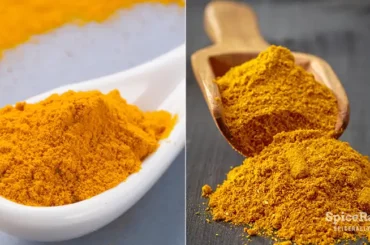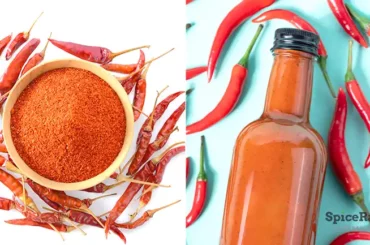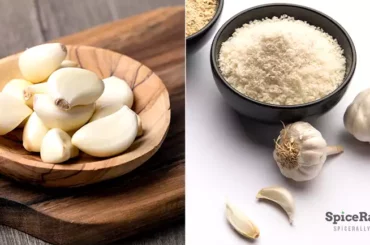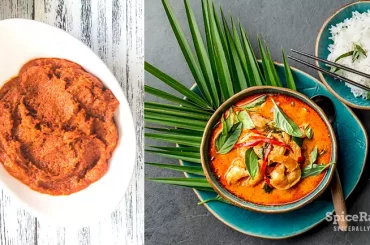Spice powders and pastes elevate our favorite dishes to a new level. But, it is crucial to know how to use them accordingly. On that note, here’s a complete guide to tikka masala powder vs tikka masala paste.
Although tikka masala powder and tikka masala paste sound the same, they have subtle differences. The most obvious difference is that tikka masala powder is a powdered spice while tikka masala paste is a fine, wet paste. In addition, tikka masala paste has more ingredients than tikka masala powder. However, tikka masala powder is more versatile than the paste in cooking applications.
So, let’s dig in and learn more about these two Indian culinary ingredients and know how to use them accordingly.
Tikka Masala Powder vs Tikka Masala Paste- Spice Rally Drill Down

| Tikka Masala Powder | Tikka Masala Paste | |
|---|---|---|
| Base ingredients | Dry spices and herbs | – Dry spice and herbs – Fresh spices and herbs – Other flavorings |
| Main ingredients | Cumin seeds Coriander seeds Black cardamom Green cardamom Black peppercorns Cloves Cinnamon Kashmiri red chiles Red chile powder Ground turmeric Nutmeg Dry mango powder Some variations might include the following ingredients: Dried fenugreek leaves Chaat masala Fennel seeds Paprika powder Black salt Star anise Mace | Garam Masala Green cardamom Black cardamom Cumin seeds Coriander seeds Cinnamon Ground turmeric Paprika Tomato puree Oil Water Salt Fresh cilantro Fresh ginger Fresh garlic Fresh red chiles Black pepper Sugar Some variations might also include the following: Onions Cayenne pepper powder Red chile powder Curry powder Chili powder Tabasco sauce Sriracha sauce Traces of nuts Corn flour Tamarind paste Other types of hot sauces Artificial color and flavor additives, acids, and preservatives To learn more interesting things about the tikka masala paste and its ingredients, click on this link and read our complete article. (Tikka Masala Paste and its Ingredients: Amazing Indian Flavors Lies Within!) |
| Base flavor | Warm and spicy | Warm and spicy |
| Flavor profile | Holds a depth of flavor due to warm spices included. Has less robustness than the tikka masala paste and usually lacks the umami, and tanginess in the tikka masala paste. | Has more robust and intense flavor notes than the tikka masala powder. Tangy and umami undertones can be savored due to additional flavorings like tomato puree and fresh spices. |
| Heat Level | Usually has a mild to moderate heat level. But this might change depending on the amount of red chile powder and red chiles included. | Usually has a mild to moderate heat level. But this might change depending on the amount of red chile powder and red chiles included. |
| Level of spiciness | The level of spiciness can be compared to that of the tikka masala paste. But it could vary depending on the amount of spices included. | The level of spiciness can be compared to that of the tikka masala powder. But it could vary depending on the amount of fresh and dried spices. |
| Texture | A fine, dried, light-weight powder | A fine, wet, thick paste |
| Color | Deep brown to reddish-brown | Deep brownish-red |
| Mode of usage in cooking | As a cooking ingredient | As a cooking ingredient |
| Usages in cooking | – Primarily used in tikka masala dishes – Flavors fusion Indian wraps and sandwiches – Can spice up certain drinks and cocktails – Boosts the flavor of egg dishes – Spices up savory doughs and batters | – Mainly used to flavor tikka masala dishes – Can combine into curries – Can be mixed with cooked salads – Spices up curry sauces and gravies – Work as a wet rub for grilling meat and seafood |
| Storage | – Can be stored at room temperature with the rest of your dry spices, herbs and spice mixtures. – Refrigeration is not required – Should be stored in an air-tight container, out of reach of direct sunlight, moisture, and heat | – Once opened, tikka masala should be kept in the refrigerator or freezer. – Storing in a tightly sealed container will ensure a long shelf life and retain its quality. |
| Mode of production | Made domestically and commercially | Made domestically and commercially |
| Availability | – Widely available in any store across India. – Can be bought from the international spice aisle of leading supermarkets, Asian grocers, or online shopping sites if you’re living outside of India. | – Widely available in any store across India. – Can be bought from the international spice aisle of leading supermarkets, Asian grocers, or online shopping sites if you’re living outside of India. |
| Origin | Peshawar, Pakistan/ India | India/ Pakistan |
More Insights On the Difference Between Tikka Masala Powder and Tikka Masala Paste
Spice pastes and powders are essential for spicy and savory food preparations. They work much more effectively in flavoring the food than individual spices and herbs would do.
That being said, we can say that the tikka masala powder and the tikka masala paste are ingredients that help create incredibly flavorful dishes. Both of these ingredients are commonly and extensively used in Indian and Pakistan cuisines for various cooking applications.
However, although both have the word “tikka” in them, they are two different ingredients with different textures, flavors, and purposes.
Differences In The Content of Tikka masala powder vs Tikka masala paste.
Tikka masala powder is a drried spice blend with only several dried spices and herbs. On the contrary, tikka masala paste is a mixture of dried and fresh ingredients.
Although the tikka masala powder typically contains only spices and herbs, tikka masala paste also includes other flavorings. You may have to incorporate other ingredients like salt with tikka masala powder to make a flavorful base.
But tikka masala paste has a more full-bodied flavor since it usually comes with a perfect balance of umami spiciness, sweetness, sourness, and saltiness. The lack of fresh ingredients makes the tikka masala powder a dry element.
On the contrary, ingredients like tomato puree, water, and oil give moisture to the paste, setting it apart from the powder.
Differences In Flavor of Tikka masala powder vs Tikka masala paste.
The next primary difference is the addition of Garam Masala to tikka masala paste. But, tikka masala powder is fundamentally a combination of individual spices. Combining the distinctive flavor notes of each dry element is its base.
On the other hand, the Garam Masala in tikka masala paste builds its base. And, other fresh spices, herbs, and flavorings back up the spiciness of Garam masala in the tikka masala paste. Due to this reason, tikka masala paste holds more robustness than tikka masala powder.
Things You Should Know About The Usage Differences and Similarities…
Everything together makes tikka masala paste a great marination spice, especially for animal proteins like meat, fish, and seafood. In the meantime, tikka masala powder functions as a much more versatile spice powder to add depth and flavor to many dishes prepared in various ways.
The main purpose of both ingredients is to add a specific flavor to tikka dishes. But still, as a powdered spice, tikka masala powder can even go out of its way and help spice up foods like rice dishes.
But, we cannot expect this from the tikka masala paste as its characteristics suit best as a marination spice. Therefore, tikka masala paste remains more of a marination spice with fewer uses while tikka masala powder has much to do regarding cooking applications.
Can Tikka Masala Powder Be Used As An Alternative Instead Of Tikka Masala Paste And Vice Versa?
As mentioned earlier, the primary purpose of these ingredients is to function as the key flavoring in tikka dishes.
Therefore, you can use tikka masala powder instead of tikka masala paste and vice versa when making tikka dishes. In addition to this, these two can serve as alternatives in place of one another in most marinations.
However, tikka masala powder is more effective in cooking than the paste. Thus, the other instances of using these as substitutions for each other are quite limited. Nevertheless, the similarity in the base flavor is a plus point as both will work well in seasoning many animal proteins alike.




